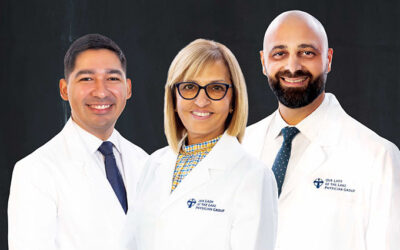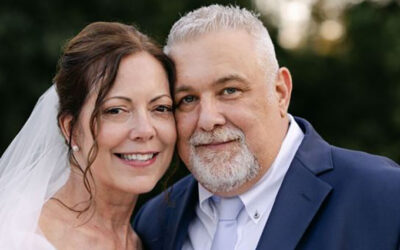Connie Gremillion was in her Abbeville home the morning of January 22, 2023, when she heard a sudden crash from the kitchen. Startled, she ran to the room to find her husband Brian on the floor trying to pick up pieces of a coffee cup he dropped.
“I asked him what had happened, and I couldn’t understand what he was saying,” Connie recalled. “I noticed something didn’t look right with his face. It didn’t seem like he could use the right side of his body. That’s when I thought he had a stroke. I called the ambulance and said I wanted to send him to Our Lady of Lourdes in Lafayette.”
At Our Lady of Lourdes, doctors determined Brian, 73, had indeed suffered a stroke. Test results revealed the type of stroke and location, which allowed providers to administer a shot of tissue plasminogen activator, or tPA. This state-of-the-art injection dissolves blood clots and effectively stops a stroke in its tracks, preserving precious brain tissue and reducing the stroke’s impact. Still, the stroke did take a toll. Brian required weeks of outpatient rehabilitation to fully regain his speech and mobility.
“The staff was amazing. They are experts in their fields and that’s really what helped me get better,” Brian said. “After a stroke, you have to listen to your doctors and stick with your rehab. You can’t quit if you want to get back to where you were before.”
Our Lady of Lourdes Health is home to a Stroke Center of Excellence, the first facility of its kind in Acadiana and one that has earned the Gold Seal of Approval from The Joint Commission for Primary Stroke Centers. The Center’s multifaceted Fast Alert program means that stroke patients receive the timeliest and highest quality medical care from the time an emergency call is made all the way through the rehabilitation process.
“The most important thing is for a stroke patient to come to the hospital right away. How much the person will recover depends on how quickly they receive medical treatment,” said Dr. Saad Karim, a vascular neurologist at Our Lady of Lourdes Health who specifically works with stroke patients.
Dr. Karim said the easy-to-remember BE FAST acronym can serve as a guide to determining whether someone may be having a stroke. If a person exhibits any of the following symptoms, they should receive immediate medical treatment:
- Balance: Inability to walk in a straight line, drifting or leaning to one side
- Eye: Double vision or vision loss in one or both eyes
- Face: Facial weakness or droopiness, particularly on one side, or a slackened appearance
- Arms: See if the person can raise both arms up and keep them up. If they cannot, there is likely a problem.
- Speech: Speech that is slurred, unintelligible or bizarre, or if a person can’t find the right words for a response
- Time: Time is of the essence. Call 911 immediately.
Dr. Karim said that while most strokes occur in older adults, they are happening more frequently in younger patients, even those in their 20s and 30s. In fact, Dr. Karim has treated stroke patients as young as 19 years old all the way up to people in their 90s.
“There are co-morbidities that are making younger people more susceptible to strokes,” he said. “We see more people with hypertension, diabetes, poor diet choices, smoking and sedentary lifestyles. A person’s overall lifestyle plays a major role in their risk of having a stroke.”
In most patients, a stroke occurs without warning. That was the case with Brian, who only experienced minor headaches and occasional weakness in the weeks leading up to his stroke – symptoms he attributed to stress or aging. Without Connie’s immediate action and knowledge of stroke symptoms, Brian’s outcome could have been much different.
“If the right treatment takes place in the right timeframe, most patients can recover and return to their previous levels of functioning,” Dr. Karim said. “We have a full checklist that we go through when every stroke patient comes in to determine the best course of action. Many people receive a blood thinning shot and then perhaps the removal of the blood clot via surgery. But, there are criteria that must be met for each of those. We evaluate each patient independently and choose the treatment that will give them the best long-term result. We also work to find out the reason that the stroke occurred in the first place and how we can prevent another one.”
In addition to treating patients at Our Lady of Lourdes in Lafayette, the hospital has a software platform connected to four smaller medical facilities in Acadiana. If a patient arrives at any of those locations with stroke-like symptoms, doctors at these outlying facilities can immediately have a video call with experts at Our Lady of Lourdes to assess the patient and administer the best course of treatment.
Today, Brian, a master plumber and gas fitter, is still hard at work at his trade. He thought he might slow down, but joked that he’s now only working with five contractors instead of six as in the past. The stroke prompted him to make lifestyle changes, including a healthier diet, new cholesterol medication, and regular visits to a cardiologist. But, thanks to his wife’s quick thinking and the treatment he received at Our Lady of Lourdes, he’s grateful that he has more time to spend doing what he loves.
“It amazes me sometimes that he is still so active. He truly loves to work. I do think the fact that he was fit and active before the stroke has helped him recover,” Connie said. “I look at him every day and think that he is a miracle.”




